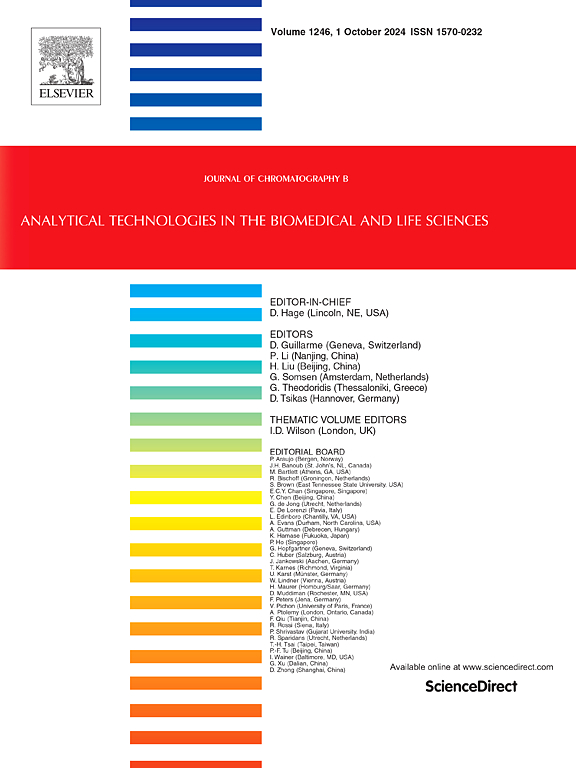Targeted analysis of seven selected tryptophan-melatonin metabolites: Simultaneous quantification of plasma analytes using fast and sensitive UHPLC–MS/MS
IF 2.8
3区 医学
Q2 BIOCHEMICAL RESEARCH METHODS
引用次数: 0
Abstract
Tryptophan-derived metabolites, a group of neurotransmitters essential for various brain functions, play key roles in regulating mood, movement, sleep, and cognition. However, the comprehensive characterisation of tryptophan-melatonin pathway metabolites is challenging due to factors such as their structural diversity, chemical complexity, low concentrations, and instability of these metabolites. In this study, we developed and validated an ultra-high performance liquid chromatography-tandem mass spectrometry (UHPLC–MS/MS) methodology with electrospray ionisation for the simultaneous separation and quantification of tryptophan metabolites in human plasma. The analytical calibration ranges in plasma were 0.50–200 ng/mL for serotonin, 0.01–5 ng/mL for N-acetylserotonin, 0.01–20 ng/mL for tryptamine, 0.01–20 ng/mL for 6-sulfatoxymelatonin, 0.01–20 ng/mL for 6-hydroxymelatonin, 0.01–100 ng/mL for melatonin, and 0.10–20 ng/mL for N-acetyltryptamine, with correlation coefficients ranging from 0.954 for N-acetyltryptamine to 0.997 for tryptamine. The intraday and interday precision remained consistently below 15 % for all analytes. Most analytes met the accuracy criteria, except for N-acetyltryptamine at the lowest quality control level (0.2 ng/mL), where the intraday and interday accuracy were 22.4 % and 17.4 %, respectively. In conclusion, this novel method allows for rapid identification of tryptophan-melatonin pathway intermediates in less than ten minutes, including seven distinct melatonin-related analytes. This suggests that it may find use in everyday clinical and scientific endeavours.

色氨酸衍生代谢物是一组对各种大脑功能至关重要的神经递质,在调节情绪、运动、睡眠和认知方面发挥着关键作用。然而,由于色氨酸-褪黑激素途径代谢物的结构多样性、化学复杂性、浓度低和不稳定性等因素,对这些代谢物进行全面表征具有挑战性。在这项研究中,我们开发并验证了电喷雾离子化超高效液相色谱-串联质谱(UHPLC-MS/MS)方法,用于同时分离和定量人体血浆中的色氨酸代谢物。血浆中羟色胺的分析校准范围为 0.50-200 ng/mL,N-乙酰羟色胺为 0.01-5 ng/mL,色胺为 0.01-20 ng/mL,6-磺酸基羟色胺为 0.01-20 ng/mL,6-乙酰羟色胺为 0.01-20 ng/mL。相关系数从 N-乙酰色胺的 0.954 到色胺的 0.997 不等。所有分析物的日内和日间精密度始终低于 15%。除最低质控水平(0.2 纳克/毫升)的 N-乙酰色胺外,大多数分析物均符合准确度标准,其日内准确度为 22.4%,日间准确度为 17.4%。总之,这种新型方法可在十分钟内快速鉴定色氨酸-褪黑素途径中间产物,包括七种不同的褪黑素相关分析物。这表明它可用于日常临床和科研工作。
本文章由计算机程序翻译,如有差异,请以英文原文为准。
求助全文
约1分钟内获得全文
求助全文
来源期刊

Journal of Chromatography B
医学-分析化学
CiteScore
5.60
自引率
3.30%
发文量
306
审稿时长
44 days
期刊介绍:
The Journal of Chromatography B publishes papers on developments in separation science relevant to biology and biomedical research including both fundamental advances and applications. Analytical techniques which may be considered include the various facets of chromatography, electrophoresis and related methods, affinity and immunoaffinity-based methodologies, hyphenated and other multi-dimensional techniques, and microanalytical approaches. The journal also considers articles reporting developments in sample preparation, detection techniques including mass spectrometry, and data handling and analysis.
Developments related to preparative separations for the isolation and purification of components of biological systems may be published, including chromatographic and electrophoretic methods, affinity separations, field flow fractionation and other preparative approaches.
Applications to the analysis of biological systems and samples will be considered when the analytical science contains a significant element of novelty, e.g. a new approach to the separation of a compound, novel combination of analytical techniques, or significantly improved analytical performance.
 求助内容:
求助内容: 应助结果提醒方式:
应助结果提醒方式:


